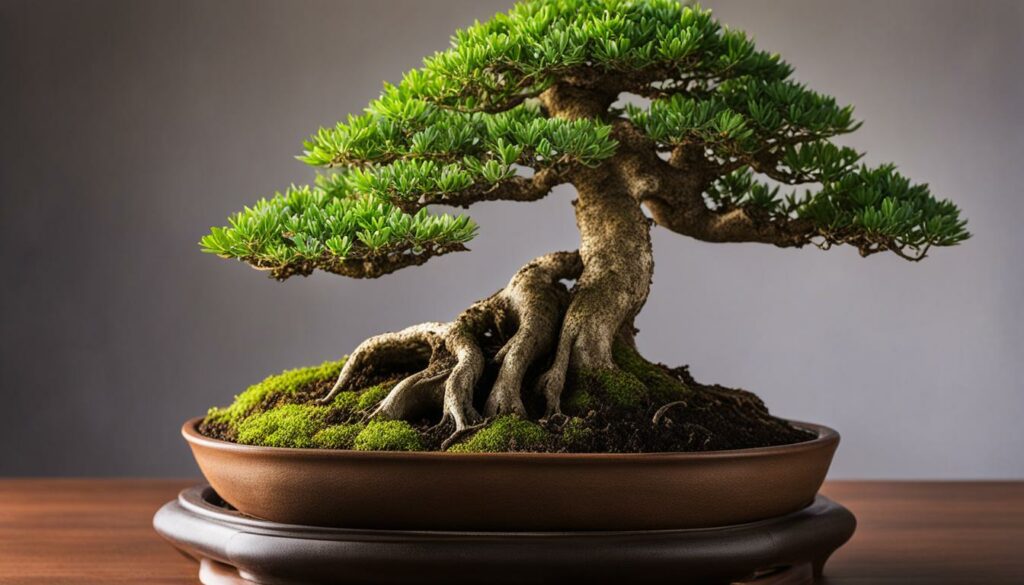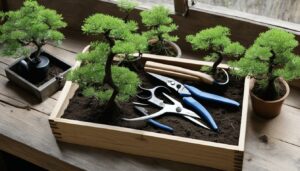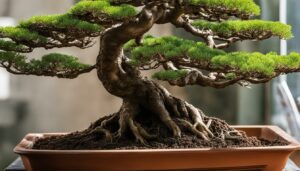In the meticulously nuanced practice of cultivating bonsai, the selection of the appropriate bonsai soil blend is not merely an option—it’s a requisite that underlines the essence of bonsai health and vitality. When your miniature tree rests within the confines of a pot, its world is fundamentally influenced by the substrate it calls home. A well-devised blend caters to the trifecta of optimal bonsai growth: it ensures sufficient nutrient uptake, precise water drainage, and effective aeration, each a critical factor that intertwines to forge a robust and elegant living sculpture.
Key Takeaways
- Understanding the vital role soil plays in the health and development of your bonsai.
- Identifying the essential components that constitute a proper bonsai soil blend for vigorous growth.
- Factoring in the unique balance of water retention and drainage when selecting your bonsai’s soil.
- Realizing the importance of soil consistency and structure in maintaining the stability and health of bonsai roots.
- Emphasizing on the necessity of choosing a soil blend that matches the specific requirements of your bonsai species.
- Considering the long-term impact of quality soil on the overall success and aesthetics of your bonsai.
Understanding the Importance of Bonsai Soil
The importance of bonsai soil cannot be overstated when it comes to the growth of bonsai trees. Unlike typical garden or potting soil, bonsai soil is a meticulously crafted medium designed to meet the precise needs of these miniature trees. The success of bonsai care hinges on the balance of nutrition, aeration, and drainage that bonsai soil provides. This unique soil fosters a thriving environment for bonsai roots, which is essential for the miniature tree’s vigor and longevity.
To fully grasp why bonsai requires its own special soil blend, consider the container’s limited space. The confined area means that every inch of soil must function optimally. Bonsai trees are delicate, and their roots require a perfect mixture of air and water—too much or too little of either, and the roots can suffer, leading to the tree’s decline. Bonsai soil is engineered to retain enough water to sustain the tree while also allowing excess moisture to drain quickly to prevent root rot.
Bonsai masters often say, “The soil beneath a bonsai is as important as the branches above.”
- Drainage: High-quality bonsai soil must have excellent drainage to ensure that water flows freely and does not waterlog the roots.
- Aeration: The soil particles are sized to create small pockets of air within the soil structure, which aids in root respiration.
- Nutrient Retention: Despite its well-draining qualities, bonsai soil should still be able to hold and supply the necessary nutrients to the tree.
A common misconception is that any soil will suffice for growing a bonsai. However, this is a far cry from the truth. The unique formulation of bonsai soil is what allows these miniature trees to survive and flourish for years, even decades. Ignoring the importance of bonsai soil is a risk to the health and growth of bonsai trees.
| Bonsai Soil Characteristic | Benefit to Bonsai |
|---|---|
| Granular Texture | Enhances root growth and allows easy trimming |
| Non-Compacting Ingredients | Prevents root suffocation and degradation of soil structure |
| pH Adjustment | Maintains the soil acidity/alkalinity at levels optimal for bonsai health |
| Inorganic Components | Ensures long-term soil stability and durability |
When you give attention to the importance of bonsai soil, you lay down the groundwork for a healthy and aesthetically pleasing bonsai that can be cherished for many generations. Remember, when nurturing a bonsai, every choice you make, from the lush canopy to the unseen soil, counts towards the art and practice of bonsai care.
The Role of Soil Composition in Bonsai Health
Understanding the essence of soil composition is crucial when caring for your bonsai. The right blend of soil impacts not only the robustness and vitality of your bonsai but also equips it to deal with varying environmental factors. Let’s delve into the materials and characteristics that define a successful bonsai soil mix.
Key Components of Bonsai Soil Mix
Each element within a bonsai soil mix serves a purpose. Akadama, a hard-baked Japanese clay, is revered for its water retention qualities. Pumice contributes to aeration and moisture management, while lava rock offers excellent drainage, ensuring that the roots of your bonsai are not waterlogged. Organic matter, often incorporated in small quantities, can add valuable nutrients to the mix. Balance in these components is essential for fostering a healthy root system and, consequentially, a flourishing bonsai.
How Soil Influences Water Retention and Drainage
The interplay between water retention and drainage is a deciding factor in the survival of bonsai species. A well-composed soil mix holds adequate moisture to sustain the tree between waterings yet drains quickly enough to prevent root rot. Here is where the particle size and soil composition play their parts. Too fine a soil can lead to waterlogged roots, while excessively coarse soil may not retain enough water, causing unnecessary stress to your bonsai.
Adjusting Soil Composition for Different Bonsai Species
Different bonsai species require tweaks to the soil composition for optimal growth. Tropical species may appreciate a mix with higher organic content for moisture, whereas desert varieties might thrive in a grittier, well-draining mix. Recognizing the needs of your bonsai species is key to adjusting the soil composition accordingly.
| Bonsai Species | Soil Composition Preference | Water Retention Needs | Drainage Requirements |
|---|---|---|---|
| Junipers | Coarse mix with minimal organic material | Low | High |
| Ficus | Richer organic content | Medium to High | Medium |
| Maples | Balanced mix of akadama, pumice, lava rock | Medium | Medium to High |
| Desert Rose | Sandier mix for sharp drainage | Low | Very High |
By carefully selecting and balancing the soil composition, you can create a conducive environment for your bonsai, aiding its growth and displaying its majestic beauty. Each material you introduce to your bonsai’s soil mix serves a crucial role in its overall health, water relations, and adaptation to its miniature habitat.
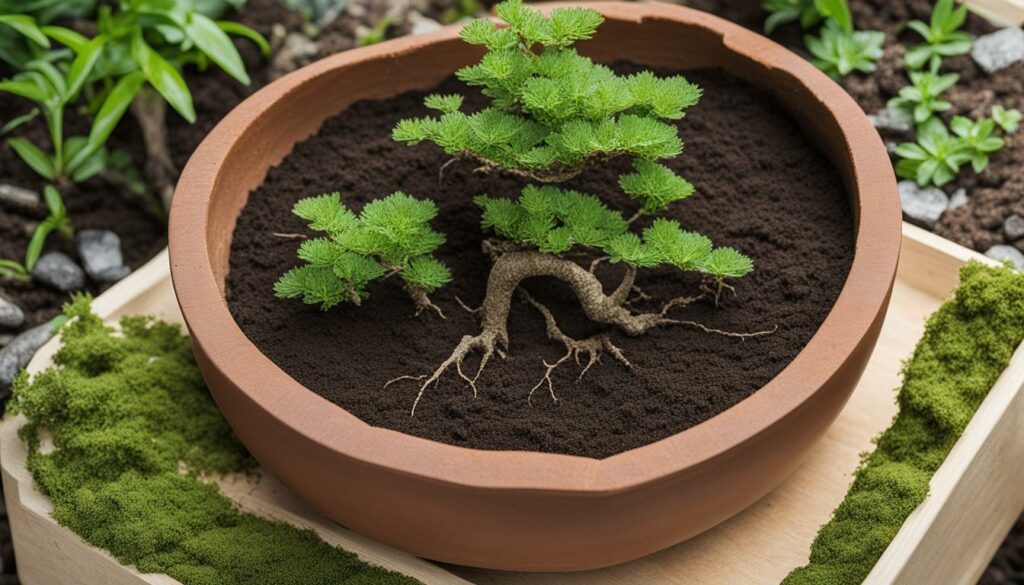
Differentiating Between Soil Mix and Bonsai Substrate
As you delve into the world of bonsai cultivation, understanding the soil mix and bonsai substrate differences becomes essential. Bonsai soil mix and bonsai substrates serve unique purposes, and choosing the right type can dramatically affect the growth and health of your bonsai trees.
To help clarify, a soil mix typically refers to a blend of various components designed to provide nutrition, support, and proper water management for your bonsai. On the other hand, a bonsai substrate is often a more specific term denoting the inorganic base materials that facilitate drainage and aeration, without contributing significantly to the nutritional content.
| Characteristics | Soil Mix | Bonsai Substrate |
|---|---|---|
| Components | Organic material (e.g., peat, bark), inorganic particles | Lava rock, pumice, akadama |
| Function | Nutrient distribution, water retention | Structural support, water drainage, root aeration |
| Life Span | Breaks down over time, requiring refreshment | Long-lasting, often reused after root pruning |
Bonsai substrate differences may appear subtle, but they are critical in ensuring that your tree’s roots receive the appropriate balance of oxygen, water, and nutrients. Whether you make your own soil mix or purchase a pre-made one, having the knowledge of what each component offers allows you to tailor your approach to each individual tree’s needs.
Remember, the success of your bonsai hinges not just on the love and attention you provide above the ground, but equally on the unseen, often complex world of soil and substrates beneath the surface.
Factors to Consider When Selecting Bonsai Soil
Perfecting the art of bonsai begins beneath the surface with the selection of the right soil. Understanding the necessities of your bonsai is paramount in choosing a substrate that caters to its growth and sustenance. Below we delve into the critical aspects of assessing your bonsai’s needs and how environmental and seasonal factors can impact your bonsai soil choice.
Assessing Your Bonsai’s Needs
If your quest is selecting bonsai soil specific to the needs of your tree, you must first consider the species. Each has its idiosyncrasies regarding moisture retention, drainage, and nutrient uptake. Age and health also play a vital role; a mature bonsai may require different soil characteristics than a younger plant, and a recovering bonsai might need soil that aids in rehabilitation.
Take into account the following when evaluating your bonsai:
- Species-specific soil requirements
- The age of your bonsai and its stage in the cultivation process
- Current health state and soil needs to bolster recovery or growth
Environmental and Seasonal Considerations
Environmental factors create a mosaic of considerations when choosing the appropriate bonsai soil. The seasonal impact on bonsai can be profound, with fluctuations in temperature and humidity necessitating a versatile medium that keeps the roots healthy and stress-free. Assess your environment through the changing seasons to anticipate soil needs:
Reflect on these environmental aspects:
- Local weather patterns and their direct influence on soil dryness or moisture retention
- Seasonal temperature shifts calling for variations in soil composition
- Indoor versus outdoor placement affecting soil temperature and humidity levels
Selecting bonsai soil can seem daunting, but by considering these critical factors, you’ll ensure that your bonsai thrives in its miniature landscape. Be mindful of how your environment changes throughout the year to adapt your soil selection, securing a healthy future for your bonsai.
DIY Bonsai Soil Mixes Versus Store-Bought
When it comes to cultivating bonsai, soil isn’t just the foundation of your plant; it’s an active component of its life and growth. You may be considering whether to mix your own DIY bonsai soil or to purchase store-bought soil mixes. The path you choose can have significant implications for the health of your bonsai and the pleasure you derive from this intricate form of gardening. Crafting your own mix affords the benefit of customization but requires a deeper understanding of soil components and their purpose. On the other hand, store-bought options offer convenience and reliability but might come with a higher price tag.
Below is a comparison to help you discern the best option for you and your bonsai tree:
| DIY Bonsai Soil | Store-Bought Soil Mixes |
|---|---|
| Cost-effective in the long run | Often more expensive upfront |
| Customizable to your bonsai’s needs | Generalized formula for broad use |
| Requires time and research to perfect | Convenient and time-saving |
| Control over the quality of ingredients | Dependent on the quality from suppliers |
| Learning experience deepens understanding of bonsai care | Less informative about the nuanced needs of bonsai |
As a bonsai enthusiast, you may relish the process of tailoring a soil blend that meets the unique drainage, aeration, and nutrient requirements of your tree. This can be particularly satisfying and effective for long-term bonsai cultivation. Yet, store-bought mixes are a practical choice for busy gardeners or those just starting out, who might prefer to circumvent the trial and error phase of DIY soil mixing.
Your decision should account for your willingness to invest either time or money, as well as how important soil customization is to the success of your particular species of bonsai. Consider your current level of expertise, the unique demands of your climate, and the specific needs of your bonsai to make an informed decision. However nuanced the choice might seem, it bemuses to remember that at the heart of bonsai is the joy of nurturing and shaping a living art form.
Deciphering Bonsai Soil Labels and Terms
Embarking on your bonsai journey, you’ll quickly discover that the path to a healthy miniature tree begins beneath its leaves, in the soil it calls home. Understanding labels and choosing the right soil—with the proper soil structure and soil particle size—is paramount. Here’s your guide to making sense of bonsai soil labels and grasping the elements that dictate the potential of your precious bonsai.
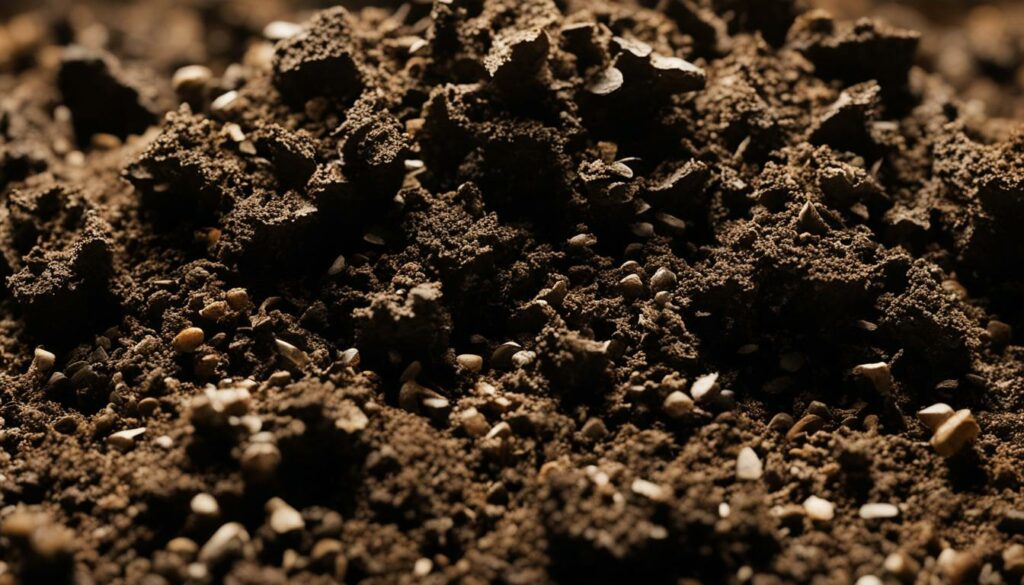
Common Ingredients Found in Pre-Mixed Soils
Bonsai soil blends are like secret recipes where each ingredient serves a purpose. Key components might include organic matter such as pine bark or compost for moisture retention, and inorganic substances like Akadama, pumice, or lava rock to improve drainage and aeration. Let’s break down some of these common ingredients:
- Pine Bark: Helps retain water and slowly decomposes to release nutrients.
- Akadama: A traditional Japanese clay that holds moisture and nutrients while still allowing air to reach the roots.
- Pumice: A volcanic byproduct that aids in water drainage and soil aeration.
- Lava Rock: Adds structure to the mix and prevents compaction.
Understanding Particle Size and Soil Structure
The sizes of the soil particles are instrumental in balancing moisture and providing a breathable environment for roots. Different species of bonsai may require varying soil structures, from fine to coarse, to thrive. Always pay attention to the specific needs of your bonsai type.
| Ingredient | Particle Size | Benefits | Best for Types of Bonsai |
|---|---|---|---|
| Akadama | Small to Medium | Water retention and aeration | Deciduous and flowering species |
| Pumice | Medium | Drainage and structure | Tropical and sub-tropical varieties |
| Lava Rock | Coarse | Drainage and root anchoring | Coniferous and pine bonsai |
| Pine Bark | Varies | Organic nutrient source and moisture retention | Broadleaf varieties |
Bonsai Soil for Indoor Versus Outdoor Trees
When it comes to nurturing your bonsai, understanding the unique soil requirements of indoor versus outdoor environments is essential. Indoor bonsai soil must accommodate less variable conditions, while outdoor bonsai are subjected to the elements, necessitating soil adjustments to optimize health and growth.
Adjusting Your Soil Mix for Indoor Bonsai Care
Indoor bonsai trees thrive in a stable environment, but they lack the natural stimuli provided by outdoor settings. To counteract this, your indoor bonsai soil should be well-draining to prevent waterlogging, yet capable of retaining enough moisture to compensate for indoor heating systems that can dry out the soil. Incorporating components such as peat moss or coco coir can enhance moisture retention while still allowing for proper aeration.
Tailoring Soil Choices for Outdoor Environments
Outdoor bonsai, on the other hand, require a soil mix that can withstand weather fluctuations, from intense rainfall to drying winds and scorching sun. Your outdoor bonsai soil mix should facilitate quick drainage, especially in regions that experience heavy rainfall. Inorganic materials like pumice or calcined clay can improve drainage and help prevent root rot during wet seasons, ensuring your bonsai remains healthy and robust.
Whether tending to indoor or outdoor bonsai, soil adjustments may be necessary as seasons change or as your tree grows. Be prepared to amend your soil mix to maintain the ideal balance of moisture, nutrients, and airflow, keeping your bonsai flourishing for years to come.
Optimizing Soil Drainage for Healthy Bonsai Roots
Ensuring your bonsai has a robust and vigorous root system is pivotal to its overall wellbeing. One crucial aspect to maintain is proper soil drainage, as it prevents waterlogged conditions that can lead to root rot and impaired root respiration. A key strategy in optimizing soil drainage lies in selecting the right materials that facilitate water movement while retaining adequate moisture for healthy bonsai roots. Let’s explore some techniques and materials that can enhance drainage in your bonsai pots.
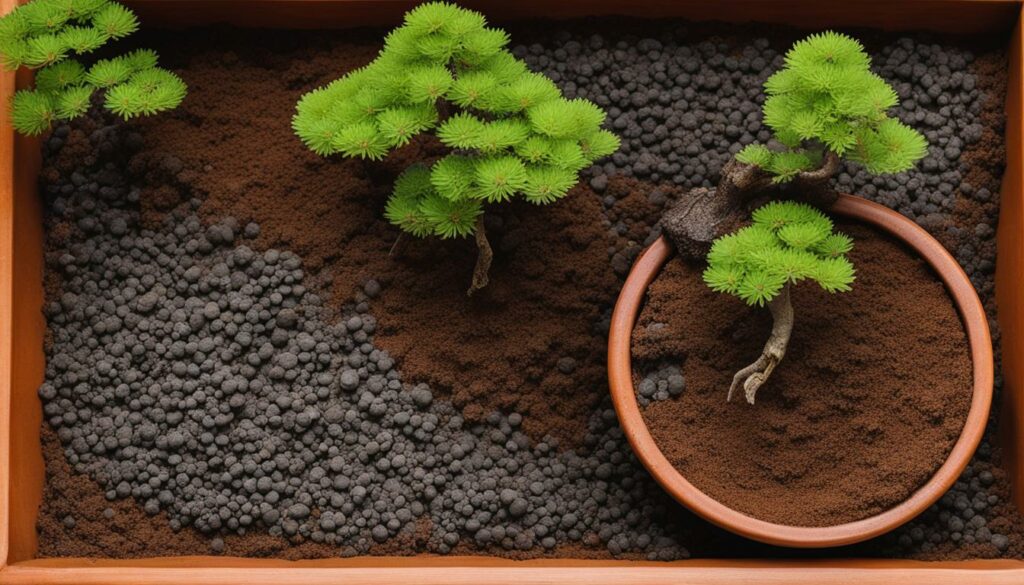
- Use non-compacting materials: Consider adding coarse sand or gravel to the soil mix. These substances help create air pockets within the soil, allowing water to flow freely and preventing the compacting of the soil over time.
- Incorporate bark or charcoal: Pine bark or horticultural charcoal can be mixed into the soil to improve its structure. These organic materials not only break up dense soil but also absorb excess moisture while slowly releasing it back to the roots as needed.
- Add pumice or volcanic rock: For a long-lasting solution, these inorganic options serve as excellent drainage facilitators. They don’t break down over time and can keep the soil airy and loose.
- Layer the bottom of the pot: Placing a layer of coarse material at the bottom of the bonsai pot — such as gravel or broken terra-cotta pieces — can prevent the soil from clogging the drainage holes while allowing excess water to escape efficiently.
- Regular soil assessment: Continuously monitor the condition of your soil. If the water drains too quickly, it might be too coarse, but if it’s too slow, additional drainage materials may be necessary.
Adapting your soil mix to cater to the needs of your bonsai’s specific species is crucial. Some species may prefer drier conditions, while others may thrive with slightly more moisture. Adjust the composition accordingly and balance drainage with water retention for a thriving bonsai. Remember that maintaining optimal drainage is a continuous process that contributes significantly to establishing strong and healthy bonsai roots.
Organic Versus Inorganic Components in Bonsai Soil
As a bonsai enthusiast, understanding the intricate balance between organic and inorganic components within your bonsai soil is imperative for the flourishing of your miniature trees. These components play distinct roles and contribute uniquely to the soil’s structure, nutrient composition, and drainage capabilities. Let’s delve into the specifics and examine how the balance of these materials can make a world of difference to your bonsai’s overall health.
The Benefits of Organic Matter in Soil
Organic components in bonsai soil, such as compost, peat moss, and bark fines, are the lifeblood of bonsai soil, offering several advantages:
- Nutrient Retention: Organic matter is adept at holding onto essential nutrients, slowly releasing them as required by the bonsai roots.
- Moisture Regulation: Acting like a sponge, these components help to retain moisture, ensuring that your bonsai stays hydrated without becoming waterlogged.
- Soil Structure Enhancement: Organic matter contributes to the soil’s structure, promoting root growth and aeration within the root zone.
- Beneficial Microorganisms: These components are also key to fostering a living soil ecosystem, supporting microorganisms that boost root health and the bonsai’s resilience.
A Closer Look at Inorganic Substrates
Inorganic matter in bonsai soil includes materials like pumice, lava rock, and calcined clay. These substrates are crucial for maintaining soil structure and health:
- Drainage and Aeration: The gritty nature of inorganic substrates fosters excellent drainage, preventing root rot and facilitating the circulation of air.
- Root Development: The inorganic particles create spaces within the soil that encourage strong root growth and branching.
- Water Distribution: These particles help distribute water evenly throughout the rooting area, mitigating the risk of over or under-watering your bonsai.
- Longevity: Unlike some organic materials, inorganic substrates don’t decompose, ensuring the soil structure remains stable over time.
Striking the right balance between organic components and inorganic matter in bonsai soil will provide your trees with a robust platform for growth, vigor, and longevity. By mindful selection and application of these soil constituents, you can create an environment where your bonsai can thrive for years to come.
Frequency of Re-potting and Soil Renewal
Re-potting bonsai is not just about giving your tree a new home; it’s about ensuring the longevity and vitality of its root system. Over time, soil degrades and becomes compacted, reducing its ability to hold air and water—both critical elements for the health of your bonsai. This is why understanding soil renewal intervals is critical. Typically, younger and faster-growing bonsai require re-potting every two to three years, while older, more mature trees may be re-potted every four to five years. However, the frequency can vary based on the species, the size of the pot, and the tree’s growth rate.
You can spot the signs that it’s time to re-pot when you notice slowed growth, roots circling the base of the pot, or when water runs straight through without being absorbed. During re-potting, not only do you refresh the soil, but you also have the chance to prune the roots, which encourages new growth and enhances the tree’s overall health.
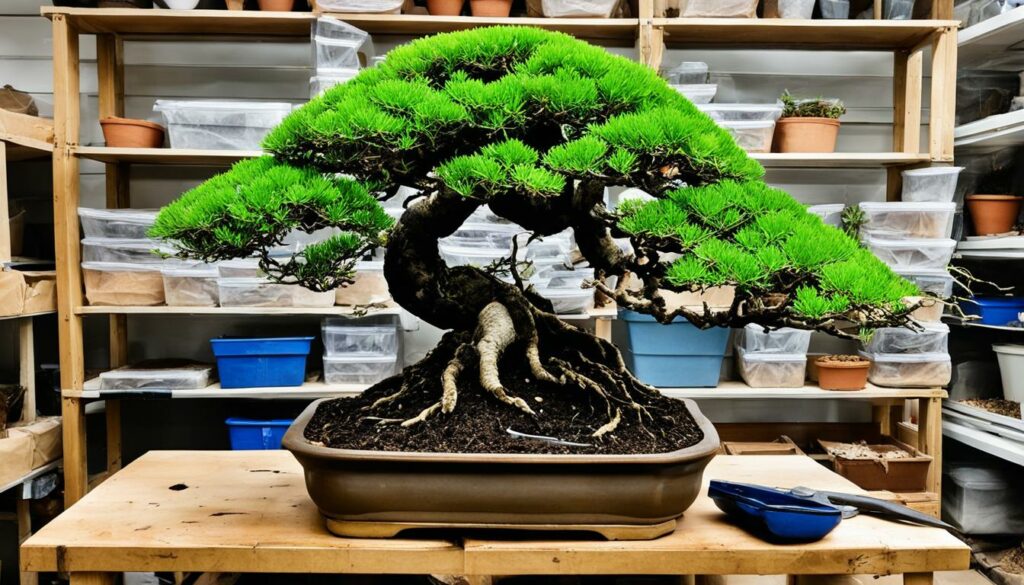
| Tree Age | Re-potting Frequency | Signs Re-potting is Needed |
|---|---|---|
| Young Bonsai ( | Every 2-3 years | Fast soil compaction, roots outgrowing the pot |
| Mature Bonsai (5-10 years) | Every 3-4 years | Moderate soil degradation, roots starting to circle |
| Old Bonsai (> 10 years) | Every 4-5 years | Slow growth, poor water absorption |
Remember, re-potting is a form of art as much as it’s a science. Always pay attention to your bonsai’s unique disposition and tailor the soil renewal intervals to its specific needs. This personalized care is what will make the difference between a surviving and a thriving bonsai.
Customizing Soil Mixes for Specific Bonsai Types
As a dedicated bonsai enthusiast, you understand that the growth and vigor of your bonsai largely depend on the quality of the soil it’s planted in. The right kind of custom soil mix can significantly affect the health and aesthetics of your bonsai, whether it’s a majestic conifer or a delicate deciduous species. Below, we delve into the specific requirements of coniferous and deciduous bonsai soils, helping you to create the optimal environment for each variety.
Soil for Coniferous Bonsai Varieties
Coniferous bonsai, such as pines and junipers, prefer a soil that offers excellent drainage while maintaining a certain amount of moisture retention. This is where custom soil mixes come into play, offering the precise balance your coniferous bonsai needs. A typical mix might include akadama, pumice, and lava rock – components that promote good aeration and water flow, ensuring that the roots of your coniferous bonsai are never waterlogged.
Soil for Deciduous and Tropical Bonsai
Deciduous bonsai like maples, on the other hand, thrive in soil that holds a bit more moisture than coniferous mixes. This can be achieved by increasing the proportion of organic components such as finely chopped pine bark or leaf mold. Tropical bonsai species, which are accustomed to a humid environment, also benefit from a moisture-retentive mix but require ample drainage to prevent root decay. Careful consideration of these aspects while customizing your soil mix goes a long way in promoting vibrant foliage and healthy growth.
Regardless of the type, creating an ideal custom soil mix is a matter of understanding the unique needs of your coniferous bonsai soil or deciduous variants. By custom-tailoring your approach, you can ensure that your bonsai not only survives but thrives, displaying the very essence of its natural beauty.
Conducting Soil Tests and Adjusting pH Levels
Accurate assessment of your bonsai’s living environment starts with conducting soil tests. These tests are crucial in determining the nutritional and pH balance of the soil, which is essential for the health of your bonsai. Ensuring that your soil has the appropriate pH level can prevent nutrient lockout, allowing your bonsai to absorb the necessary minerals effectively.
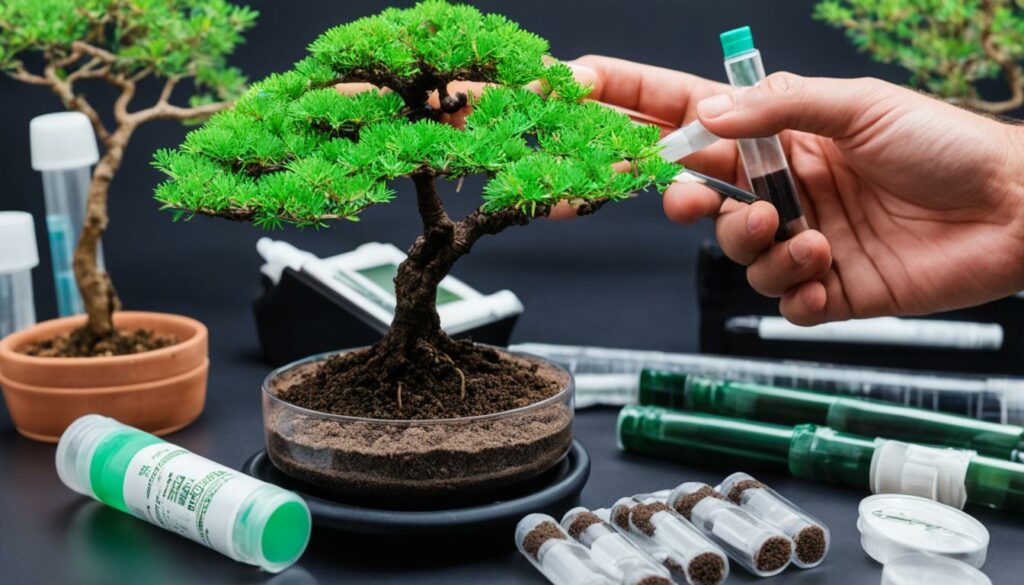
To begin testing, secure a reliable soil test kit from your local gardening center or order one online from a reputable brand. Use this kit to measure not just pH but also the levels of nitrogen, phosphorus, and potassium, which are vital for the growth and health of your bonsai tree.
If your soil test reveals a pH imbalance, adjusting soil pH is the next step. Depending on whether your soil is too acidic or alkaline, you’ll need to add specific amendments to neutralize the pH. For acidic soils, incorporating lime can raise the pH, while sulfur or peat moss can help to lower the pH of alkaline soils.
| Soil Condition | If Too Acidic | If Too Alkaline |
|---|---|---|
| Recommended Amendment | Lime | Sulfur or Peat Moss |
| pH Adjustment Time Frame | Several months | 1-2 months |
| Frequency of Testing | Every 3-6 months | Every 3-6 months |
| Important Consideration | Application rate based on soil test results | Application rate based on soil test results |
Please note that when adjusting soil pH, changes do not occur overnight. It usually takes a few months for amendments to fully influence the soil composition and pH level. Continue to test the soil periodically and allow time for the adjustments to take effect. Patience and persistence in monitoring and modifying soil conditions will ensure the continued health and vigor of your bonsai.
Advanced Bonsai Soil Techniques for Veterans
As you delve deeper into the art of bonsai cultivation, understanding the intricacies of soil science becomes paramount. It’s here where your experience can truly shine, manipulating the very foundation of your bonsai’s health and longevity through advanced soil techniques. Tailoring soil amendments and fostering synergistic relationships with mycorrhizal fungi represent the cornerstones of elite bonsai care.
Experimenting with Soil Amendments
Bonsai enthusiasts with a penchant for perfection know that soil amendments are key to achieving that ideal balance of drainage, aeration, and nutrient content. The judicious use of ingredients like volcanic rock, fired clays, and fine gravels can significantly improve the physical properties of your bonsai soil. Yet, the benefits don’t stop at texture and water management; some amendments can also infuse the soil with essential microelements, bolstering your bonsai’s vigor.
Consider, for example, the use of biochar, a highly porous form of charcoal that not only aids in aeration but can also serve as a repository for beneficial microorganisms. Similarly, zeolite is known for its high cation-exchange capacity, trapping ammonia and releasing it slowly as needed, thereby regulating the availability of nutrients.
Understanding Mycorrhizal Fungi’s Role in Bonsai Soil
Your bonsai’s roots are not alone in their subterranean realm. Joining them is an array of mycorrhizal fungi, forming a symbiotic relationship that can boost your tree’s stress resilience and improve its intake of water and nutrients. These fungi extend the reach of roots through their hyphae, acting as living conduits that tie the underground ecosystem together.
Inoculating your bonsai’s soil with mycorrhizal fungi can lead to a dramatic improvement in your tree’s performance. This is particularly true for species that rely on these natural partnerships to thrive in the wild. When you introduce these beneficial fungi, you’re echoing the complex relationships found in your bonsai’s natural habitat, promoting a healthier, more robust miniature landscape.
As you continue advancing your bonsai practice, remember that the soil you cultivate is as alive as the trees themselves. Through thoughtful amendments and enhancing fungal allies, your bonsai will not only survive but thrive under your dedicated care. Let the subtleties of soil ecology enrich your bonsai’s world, as the unseen often holds the key to the splendor that captivates the eye.
Conclusion
Throughout this comprehensive journey, we’ve explored the intricacies involved in maintaining bonsai health through the artful science of soil selection and management. Every step, from understanding the crucial difference between various soil components to mastering the timing of re-potting, coalesces into a cohesive bonsai soil selection guide. Your newfound knowledge equips you with the prowess to discern the unique needs of your bonsai, ensuring its longevity and vibrance.
Remember, the soil you choose acts as the foundational support for your bonsai, much like the bedrock to a towering tree. It’s not simply about providing a base; it’s about fostering a thriving ecosystem where your bonsai can prosper. By tailoring your soil blend to meet the precise requirements of your bonsai species, considering environmental factors, and embracing the balance between organic and inorganic substrates, you hold the key to unlocking the fullest potential of these miniature wonders.
As we conclude, let us imprint upon your mind the paramount significance of continued learning and experimentation with bonsai soil. The methodologies laid out herein are not static, for as your bonsai grows, so too should your understanding and techniques evolve. Carry forward the wisdom from this guide and watch as your hands, once unsure, become the skilled hands of a seasoned bonsai cultivator. May your dedication to the craft be as steadfast and enduring as the trees you tend to. With this guide as your ally, may you cultivate not just bonsai, but a legacy of growth and beauty.
FAQ
What are the key components of a bonsai soil mix?
The key components of a bonsai soil mix typically include akadama, pumice, lava rock, organic matter like pine bark, and sometimes sand for increasing drainage and aeration. The exact composition can vary depending on the specific needs of the bonsai species.
How does the soil composition influence water retention and drainage for bonsai trees?
Soil composition plays a critical role in water retention and drainage. Materials like akadama retain water well, while pumice and lava rock improve drainage, ensuring the roots don’t become waterlogged. A good soil mix balances these aspects to provide adequate moisture without suffocating the roots.
Why is it necessary to use bonsai-specific soil instead of regular potting soil?
Bonsai trees have unique care requirements, including the need for a soil mix that provides proper drainage, aeration, and nutrient retention. Regular potting soil is often too dense for bonsai roots, can retain too much moisture, and may lack proper aeration, leading to root rot and other health issues.
What is the difference between a soil mix and a bonsai substrate?
A soil mix typically refers to a blend of various components like akadama, pumice, and organic material customized for bonsai care. A bonsai substrate, on the other hand, might refer to any single soil component or to inorganic materials used in the mix. Understanding these terms helps in choosing or creating the right environment for your bonsai.
How often should I repot my bonsai and replace the soil?
Repotting frequency depends on the bonsai’s species, age, and growth rate. Younger, faster-growing bonsai may need repotting every year, while older trees might only require it every 3-5 years. You should replace the soil each time you repot to ensure your bonsai has a fresh, nutrient-rich environment.
Can I make my own bonsai soil mix, and how does it compare to store-bought mixes?
Yes, you can create your own bonsai soil mix, and it allows for customization to match your specific bonsai’s needs. Homemade mixes can be more cost-effective and tailored than store-bought ones, but they require knowledge of the ingredients and their proportions. Store-bought mixes offer convenience and consistency, especially for beginners.
What should I consider when selecting bonsai soil for indoor versus outdoor trees?
When selecting bonsai soil for indoor trees, consider factors such as lower light levels and potentially drier air, which might affect moisture retention. For outdoor trees, the soil mix should account for climate factors like rainfall, temperature, and humidity. Both scenarios require soil that provides excellent drainage to support healthy bonsai growth.
What benefits do organic components provide in bonsai soil?
Organic components like pine bark or compost can improve the soil’s structure, providing better aeration and moisture retention. They slowly release nutrients as they decompose, which supports the bonsai’s health. However, the quantity should be controlled to ensure proper drainage and to prevent overwatering issues.
How do I adjust the pH levels of my bonsai soil?
To adjust the pH levels of bonsai soil, you can perform a soil test to determine the current pH. Depending on the result, you can add lime to raise the pH or sulfur to lower it. It’s important to adjust pH gradually and monitor the bonsai’s response to avoid stressing the tree.
What are soil amendments, and when should they be used in bonsai soil?
Soil amendments are materials added to soil that improve its physical properties. For bonsai, amendments can include materials that enhance drainage, aeration, or water retention, depending on what the soil lacks. They are used during repotting or if the current soil’s performance is not meeting the bonsai’s needs.
